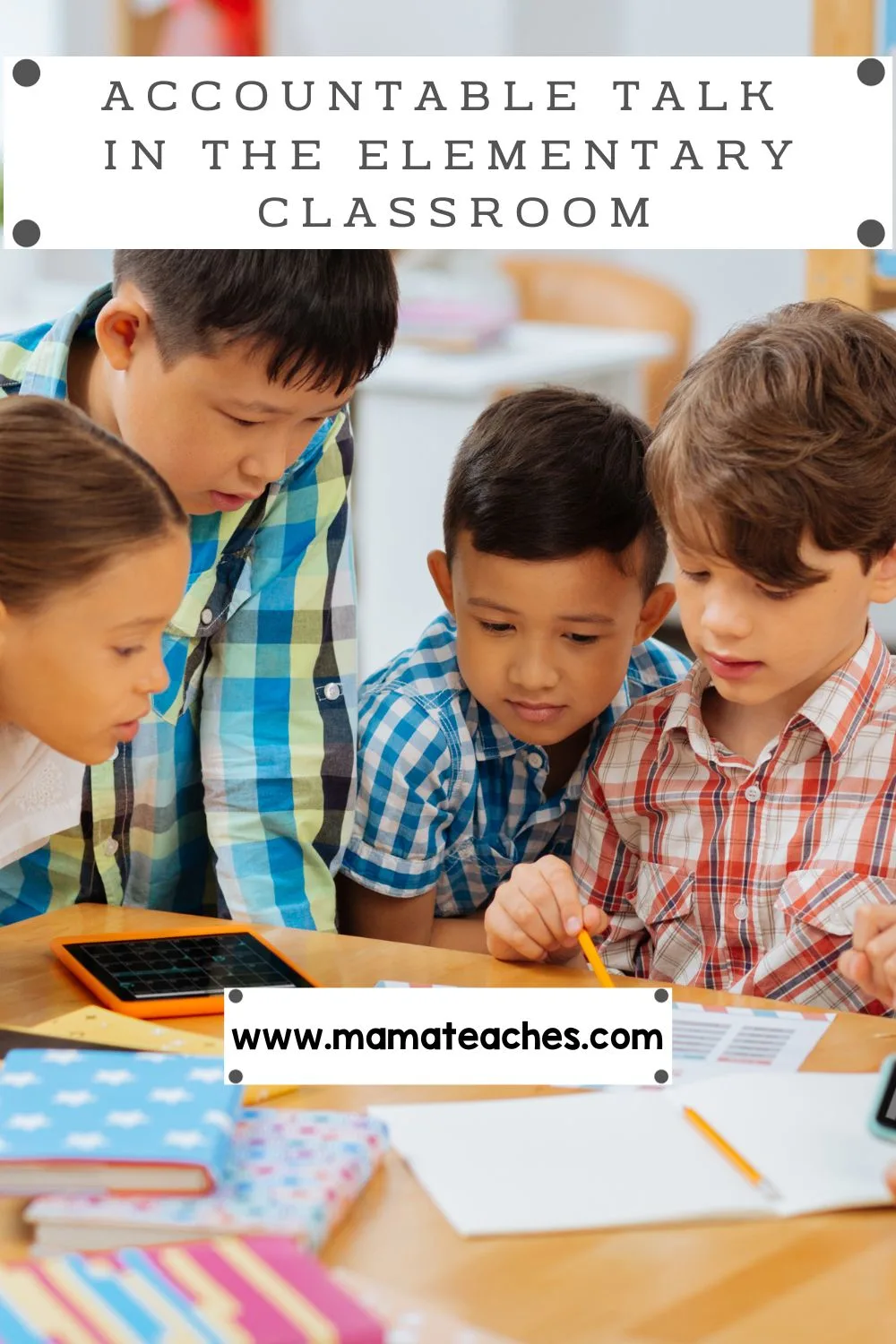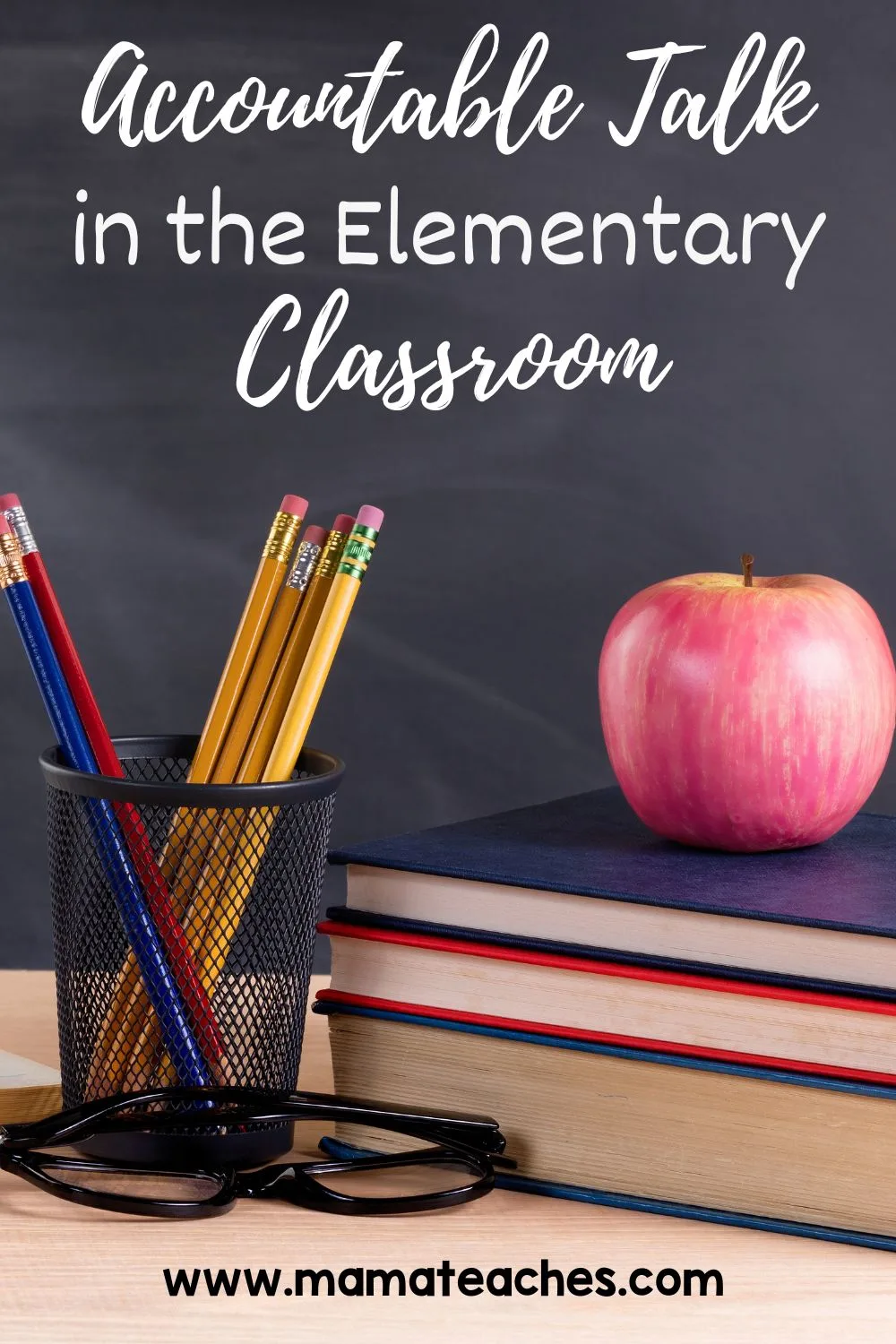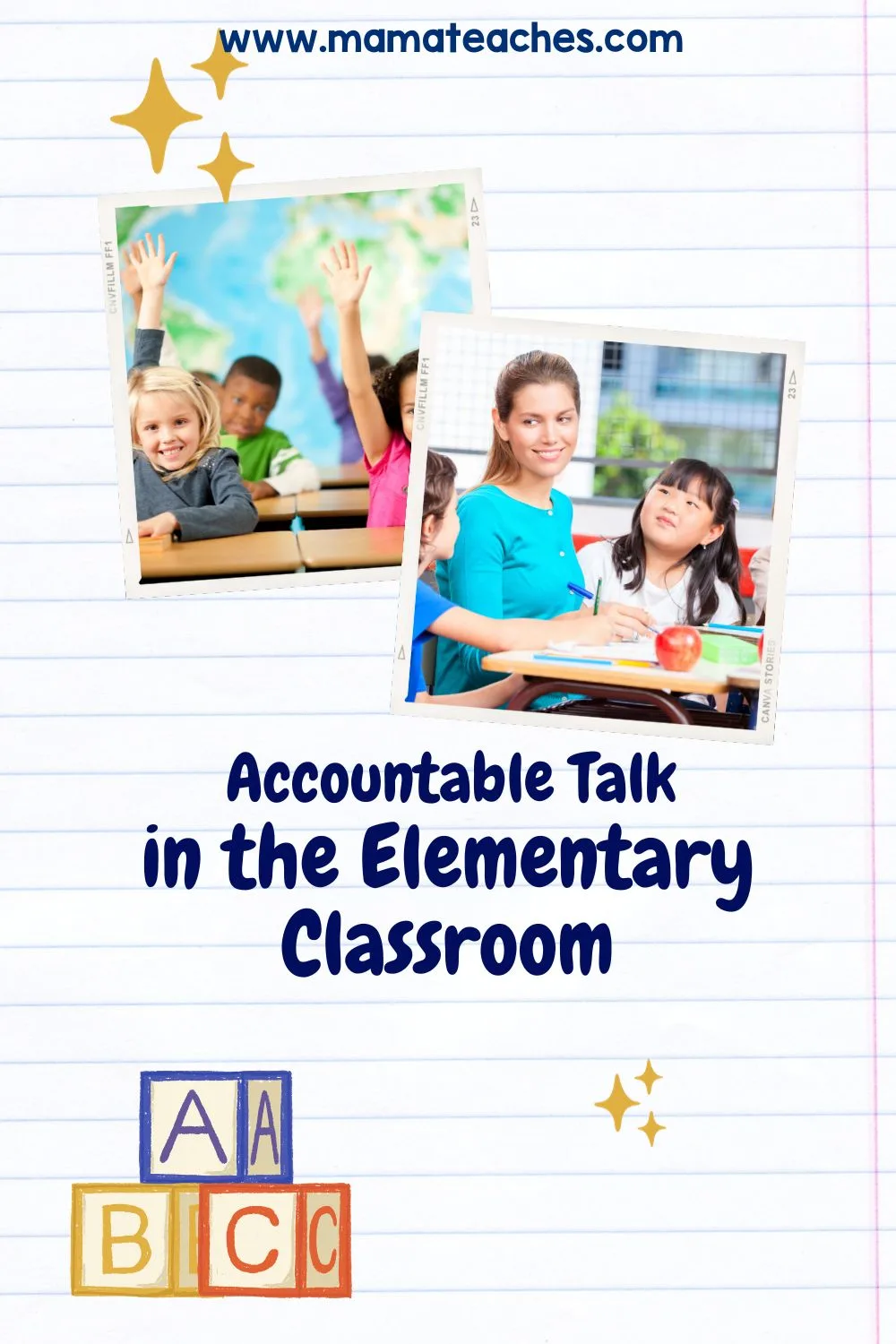Do you want your elementary students to have more meaningful class discussions? Teach the concept of Accountable Talk.

What Is Accountable Talk?
Do you ever feel like your students aren’t listening and responding to you or one another?
Do their comments seem disjointed (or even disrespectful)?
Is it difficult for conversations to get beyond the surface and into deeper levels of thinking?
Accountable Talk is the answer.
Accountable Talk is a communication method that focuses on asking open-ended questions and genuinely listening to the person’s response.
Your elementary students can engage in meaningful conversations (especially in content-rich subjects like literature, history, and science).
Not only does it promote higher-level thinking, but it forms connections between people and builds classroom community.
The skills needed for Accountable Talk are interpersonal skills that will last a lifetime. Why wait to learn them?

This article contains affiliate links to things that you might like.
What Are the Components of Accountable Talk?
Accountable Talk must be three things:
Accountable Talk Encourages Understanding
This is how you are accountable to your classroom community.
It is not enough for one person to understand. Everyone must understand. That is the goal of the conversation.
Helping others to understand involves rephrasing, summarizing, or restating.
It also involves active listening. The listener may need to ask clarifying questions.
Accountable Talk Is Accurate
Accountable Talk pursues what is true.
To that end, you should use correct information when you are having a conversation.
You may need to consult the book you are discussing or research an answer you don’t know.
Accountable Talk Leads to Deep Thinking
When you ask open-ended questions, you invite students to think logically and critically.
They must reason to find the answer and then explain it to the group.

How to Explain Accountable Talk to Elementary Students
Elementary students can grasp the purpose of Accountable Talk, and you can teach them the ground rules of conversation.
You can tell your students, “We will practice discussing with Accountable Talk.
The goal of this discussion is for everyone to understand one another.”
“We want to think deeply, explore ideas, and learn together.”
The Ground Rules of Accountable Talk
Teach your students the ground rules of Accountable Talk.
Show the speaker you are listening to them by looking at them.
It is not enough to listen to a person; you need to show them you are listening.
The speaker will know you are listening to them if you look at them while they speak.
Control your face and body when you are listening.
You can communicate with someone without saying a word.
What are you communicating when you roll your eyes, yawn, slump in your chair, or incessantly fidget while someone else speaks?
You are telling them you disagree, or worse, that you don’t care about them.
Do your best to control your face and your body during Accountable Talk.
This can be challenging for elementary students, so set a timer during Accountable Talk.
Try it for 10 minutes, and then take a break.

Everyone must contribute to the conversation.
The goal of Accountable Talk is to have a balanced conversation.
A balanced conversation means that everyone contributes in equal measure.
Everyone should contribute at least one idea and ask one question during Accountable Talk.
You can even keep track of this with hash marks.
If need be, you can make the rule that no one can contribute more than twice until everyone has offered a question or idea.
Build on what others are saying.
If everyone takes turns talking, but no one responds to one another, you are just taking turns making speeches.
You aren’t having a discussion.
If someone’s statement gives you an idea, let them know.
Teach your students this phrase, “To build on what [person’s name] was saying…”
Ask them to use it in conversation at least once.
At first, it will seem robotic, but over time, they will get the hang of it.
You can build on what someone else is saying with comments like:
“What you said made me think about…”
“That was really helpful. I had not thought about…”
“To add to what you are saying, I think another reason/example is…”

Ask a question if you don’t understand what someone is saying.
Remember, the goal of Accountable Talk is that everyone must understand.
If you don’t understand what someone is saying, ask them politely to explain it more clearly.
It’s wonderful to hear, “I’m not sure I understand. Can you explain that to me again?”
Find polite ways to express disagreement.
Disagreement is perfectly fine! That’s what makes a conversation exciting.
Disagreement is also how we clarify our ideas and find the best solutions.
(That is why our legislators debate when writing and passing laws.)
However, students need to learn how to express disagreement politely.
Teach them phrases like, “I see that a different way.”
The goal of the conversation does not have to be agreement.
It’s okay to end a discussion with, “You have given me a lot to think about.”

How to Teach Accountable Talk to Elementary Students
Charts and sentence starters are a gold mine when introducing accountable Talk.
Here are some ideas:
How to Listen
Make some pictures or catchphrases that summarize how to listen well.
Look at the person speaking. Sit up straight. Watch your face.
Ask Good Questions
Higher-level thinking questions start with phrases such as these:
- How would you describe…
- Why was it important that…
- Can you give an example of…
- Do you agree or disagree that…
- What would you do if…
Build on What Others Are Saying
Start with one phrase and add to the list over time.
“To build on what X was saying…”
Ask Clarifying Questions
Again, start by introducing one way to ask a clarifying question and then add to the list over time.
“I don’t quite understand. Can you explain that a different way?”

Express Disagreement Politely
Just like the others, start with one phrase. Add to the list over time.
“I hear what you are saying, but I see that differently.”
Activities for Accountable Talk
You can have an Accountable Talk discussion on most content subjects. Here are some ideas:
Role-Playing
To introduce Accountable Talk, you can role-play a conversation between fairy tale or fable characters.
For example, why did the troll guard the bridge from the three Billy Goats Gruff? Could they state their sides and come to a resolution?
Literature
Accountable Talk works exceptionally well when you are discussing a book.
Why did the characters make the choices they did?
Do you agree or disagree?
What is the story’s lesson? (Or is there one?)
Science
Do a science demo and have the students discuss what happened.
Why do they think the result was X?
What might happen if they did the experiment differently?

History
Look at a historical event or a person from history.
What causes led to this event happening? What happened afterward?
Why did this person decide to ___? Would you make the same decision?
What were the circumstances of this event?
Classroom Rules
If your students feel like they helped form the classroom rules, they are more likely to follow them.
You can ask questions like, “What were the rules you had in the past?”
“Which rules were hard to follow and why?”
“How do you want to treat others in class?”
Assessing Accountable Talk
As a teacher, you may need to set a time limit for Accountable Talk.
You can start with ten minutes for a large group discussion, or you can break the class into smaller groups and have the groups take turns for 5 minutes.
It would be best if you had a few higher-level questions to get the group started in the discussion, but think of yourself as the facilitator, not a participant.
Have the students sit in a circle, if possible, so that they can look at one another.
Make a note every time a person speaks.
Jot down when someone makes an insightful comment, listens well, asks a clarifying question, or disagrees politely.
At the end of the 10 minutes, ask the students what they thought of the conversation.
Did they balance the conversation so everyone participated equally?
Did they listen well and communicate their attention?
Then, you can give your feedback. How many times did each person speak? What did each person do well?
What is one thing the group could do to improve for their next Accountable Talk discussion?

Using Accountable Talk in the Elementary Classroom
Accountable Talk can transform classroom discussions and teach your elementary students valuable critical thinking and interpersonal skills.
Give it a try with these instructions and activities.
